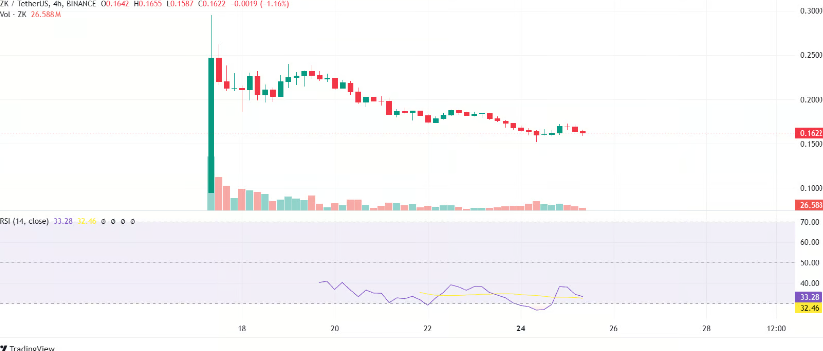As of the latest update, the ZKSync token, ZK, shows some limited trading activity, with an increase of merely 0.5% in the last 24 hours. Hence, the changes that make ZKSync upgrade from a ZK rollup chain to an “elastic chain” imply a transition from a single ZK chain to a network of multiple ZK chains with a focus on integration and improved user experience.
The v24 upgrade, which was initiated on June 7th, has a significant position in ZKSync’s 3.0 roadmap and is achieved by turning its native bridge into a token vault that promotes interoperability between more ZK chains.
The airdrop before this upgrade was quite contentious, with ZKSync distributing 3. 675 billion ZK tokens, a number higher than 17. This is equivalent to 5% of the total number of tokens for rewards to early users and developers of the L2 network.
As of 5:16 am ET on Tuesday, June 25, ZK, the native token of ZKSync, reveals lukewarm price action with a marginal up-0.5% from the previous 24 hours to $0. 1624, together with a significant 41.16% trading volume of $278 million, rising 16% according to data collected from CoinMarketCap.
ZK presently occupies the 108th position in the market with a market cap of $596 million and has been down by 47.63% in the recent past. Undefined $0.3098 on June 17, 2024, with a 27.45% decline over the week and a 43.46% undefined
Furthermore, it has a relatively low RSI of 33.28, which is near the oversold signal; ZK gives buyers a chance to get into the market at better prices.

ZKSync Era Begins: Introducing the New Upgrade
The elastic chain architecture ensures a streamlined user experience with transactions requiring just one wallet confirmation, eliminating network switching and manual asset bridging.
ZKSync Era’s upcoming upgrade aims to establish a foundational layer for over 20 chains on the mainnet by 2024-end, featuring prominent projects like Lens Protocol, QuarkID, PlayFi, GRVT, Cronos zkEVM, and Noodle.
The introduction of an elastic blockchain by ZKSync developers at the 2022 SmartCon event emphasizes improved proof aggregation and cross-chain interoperability, supported by the foundational ZK Stack upgrade.
The elastic chain architecture will adopt the Ethereum Multi-Chain Address (EMCA) standard, enhancing address identification across multiple chains by incorporating chain-specific details.

